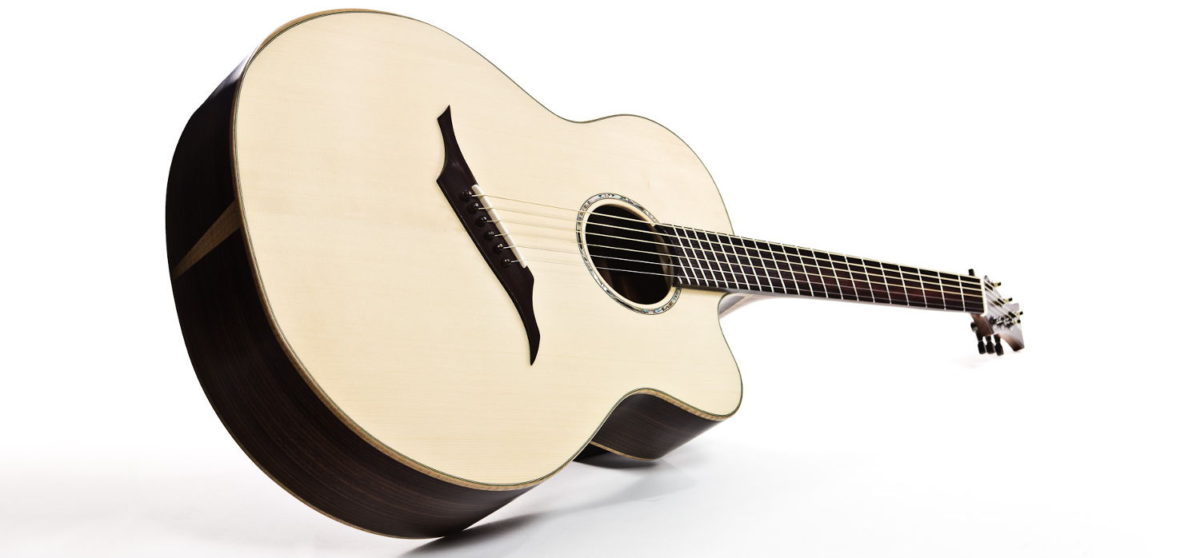Magazine: Akustik Gitarre 02/2012 | Author: Andreas Schulz
Christian Stoll, German luthier from the Taunus region, is actually known for his traditionally oriented instruments. With his new IQ-Steelstring he has picked up some of the interesting guitar building trends of the last years. This test was fun: a steel string acoustic built in a traditional way with modern ingredients, which plays great and shone with an amazingly open sound during the recordings for the ACOUSTIC GUITARRE CD.
Construction
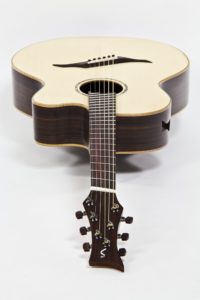
Stolls IQ is a jumbo steel string with a Sitka Spruce top and Rosewood back and sides. The woods used are solid and of selected quality, the top has been bookmatched, clearly visible by the two small bearclaws in the grain. The curved cutaway starts at the 17th fret, the top and bottom bindings are made of Anigré (an East African hardwood). The silky shining nitrocellulose finish of the instrument provides a pleasant haptic feeling. Not common for a steel string is the construction with a Spanish heel joint - this suits Stoll's style as a luthier. The only decoration is a sound hole rosette made of abalone. The strikingly curved Rosewood bridge could almost be accepted as decoration as well. It carries a bone bridge saddle, the strings are held by Rosewood pins with abalone dots.
The neck is made of spanish cedar, with a glued heel. Striking is the modern curved asymmetrical headstock with rosewood veneer and inlaid abalone signature. The machine heads are intentionally not set parallel - the result is an almost straight string line from the nut to the machine heads. The tuners are Schaller M6 mini with Rosewood buttons and work with the usual ease. The bone nut design also gives no cause for criticism, the strings are easy to tune and do not stick. The rosewood fingerboard has 20 frets (21 for b2, 22 for e1), the neck-body transition is at 14th fret. Only small dots on the upper edge of the neck show the way as position markings. The frets have an unobtrusive medium format and are perfectly inserted, deburred and polished.
Special Features
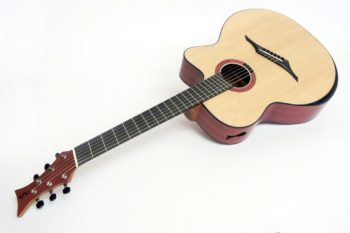
If you have never seen a fanned-fret guitar before, you will be baffled by its surprising appearance. The idea of such a multi-scale fretboard: the scale length increases from the high to the low strings, but bridge and saddle are placed at opposite angles. The vibrating string length measures 645 mm on the high E-string and 683 mm on the low E-string. Accordingly, the frets are not aligned parallel, but fanned.
Further construction details relate to the body. At the resting point for the right arm we find a bevel, a smoothing (flattening, levelling) of the body edge. This is discreetly realised by a widened binding, which is rounded off in a hand caressing design and is optically and technically perfectly executed. The sound hole in the side, a small additional opening in the upper bout, is designed to give the guitarist more control over his own tone and articulation. The shape matches the headstock and bridge, the opening is quite small but provides the desired effect.
Handling and Sound
Christian Stoll's IQ-Steelstring is of high quality workmanship, therefore the instrument is a pleasure to handle. The maximum body width is about 43,5 cm - a large-sized jumbo guitar with a lot of volume.
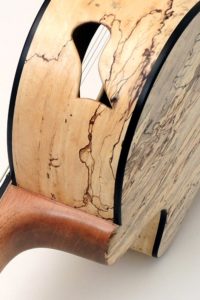
How does the fanning affect the playing feel? My experience: After a short time you get used to it and play with great ease; small corrections of position with widely spread fingerings over several frets are automatically corrected by the left hand. However, fingerboard markings would be desirable - large positional jumps towards the 12th fret can go wrong and one plays unintentionally "outside".
Bevel and side sound hole have a positive effect. In spite of a discreet execution, pleasing effects are noticeable. When playing for a longer period of time, the upper edge of the body does not press disturbingly on the arm - a clear relief for those who play a lot. The additional sound hole, as an extra monitor facing the player, has a noticeable effect despite its small size: You have better control over your own playing and hear yourself more clearly in ensemble situations. According to Christian Stoll, the size is designed in such a way that the effect is positive for the player without changing the sound forward.
The IQ has a sound all of its own. The tone is large and voluminous, yet amazingly brilliant. The guitar really pops and sets itself prominently in scene with an extra portion of overtones. The basic tone is rather modest, which is noticeable with single notes in the higher registers, which have only a subtle low-frequency attack on the upper three strings. The body volume of this jumbo steel string ensures that the sound is nevertheless powerful and fundamental.
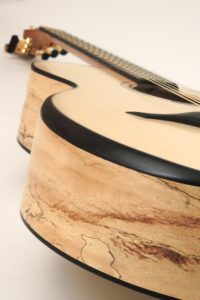
Also on the credit side is the reaction to the articulatory subtleties of the player: one can also get warm and almost velvety tones out of the guitar - or in the next moment play offensively forward with energetic strummings or arpeggios. The fannet frets have two important effects. The intonation of Stolls IQ is exemplary over the entire fretboard. You can move a voicing with fourths or fifths from the 1st to the 17th fret without the clean tuning of the intervals being compromised. Amazing - almost every standard guitar reaches its limits here.
Conclusion: Intonation and positioning of the frets and the resulting integrity of chords are perfect. The longer scale length of the low strings provides higher string tension and clear bass, single notes remind of the sound of a piano. You can use normal string sets, the test guitar had 012 Elixir strings.
Pleasant side effect: the extended scale length in the basses gives room for down-tuning; the low E-string can be tuned down by a fourth with a reasonable playing feel and intonation. Tunings like CGCGAD are possible without problems, with tight bass and a remarkably wide dynamic range. Stylistically, this model is more suitable for modern styles and can be used musically to great effect with plectrum and fingerstyle techniques. Tone and appearance go well with new-age pickings, percussive playing techniques or sophisticated fusion pieces with challenging playing technique. However, a blues and roots environment would be less suitable to the instrument.
Conclusion
Christian Stoll has successfully created a model with modern ingredients. The combination of the special features fanned frets, bevel and side sound hole is successful and together with the solid base of a handmade solid jumbo steel string it makes a grandiose instrument with which you will attract attention. The overtone-rich sound with its clear articulation as well as the extremely clean intonation in all registers make Stolls IQ an exceptional soloist guitar.
Infos
| Guitar tested: | IQ-Steelstring |
| Download PDF (german): | Review Akustik Gitarre 02/12 Stoll Guitars IQ |
 |
|

